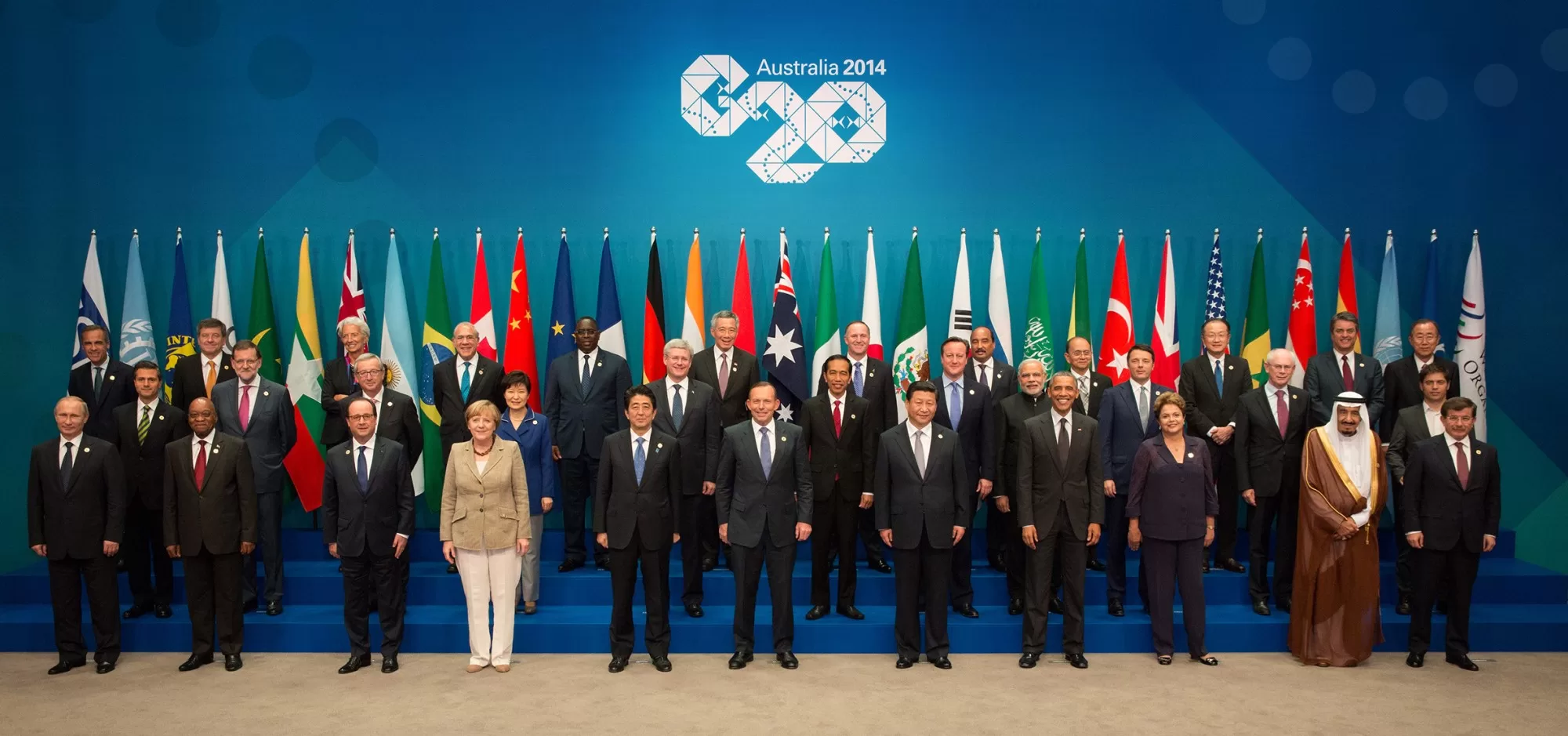What is G20 summit ?

What is G20 summit
The G20 or Group of 20 is an intergovernmental forum comprising 19 sovereign countries, the European Union (EU), and the African Union (AU). It works to address major issues related to the global economy, such as international financial stability, climate change mitigation and sustainable development.
The G20 is composed of most of the world’s largest economies‘ finance ministries, including both industrialised and developing countries; it accounts for around 80% of gross world product (GWP), 75% of international trade, two-thirds of the global population, and 60% of the world’s land area.
The G20 was founded in 1999 in response to several world economic crises. Since 2008, it has convened at least once a year, with summits involving each member’s head of government or state, finance minister, or foreign minister, and other high-ranking officials; the EU is represented by the European Commission and the European Central Bank. Other countries, international organizations, and nongovernmental organizations are invited to attend the summits, some permanently.
In its 2009 summit, the G20 declared itself the primary venue for international economic and financial cooperation. The group’s stature has risen during the subsequent decade, and it is recognised by analysts as exercising considerable global influence; it is also criticised for its limited membership, lack of enforcement powers, and for the alleged undermining of existing international institutions. Summits are often met with protests, particularly by anti-globalization groups.
In September 2023, at the 18th G20 Summit, Indian PM Narendra Modi announced that the African Union has been included as a member of the G20, making it the 21st member.
What is G20 summit
History
The G20 is the latest in a series of post–World War II initiatives aimed at international coordination of economic policy, which include institutions such as the “Bretton Woods twins“, the International Monetary Fund and the World Bank, and what is now the World Trade Organization.
The G20 was foreshadowed at the Cologne summit of the G7 in June 1999, and formally established at the G7 Finance Ministers’ meeting on 26 September 1999 with an inaugural meeting on 15–16 December 1999 in Berlin. Canadian finance minister Paul Martin was chosen as the first chairman and German finance minister Hans Eichel hosted the inaugural meeting.
A 2004 report by Colin I. Bradford and Johannes F. Linn of the Brookings Institution asserted the group was founded primarily at the initiative of Eichel, the concurrent chair of the G7. However, Bradford later described then-Finance Minister of Canada (and future Prime Minister of Canada) Paul Martin as “the crucial architect of the formation of the G20 at finance minister level”, and as the one who later “proposed that the G20 countries move to leaders level summits”. Canadian academic and journalistic sources have also identified the G20 as a project initiated by Martin and his American counterpart then-Treasury Secretary Larry Summers. All acknowledge, however, that Germany and the United States played a key role in bringing their vision into reality.
Martin and Summers conceived of the G20 in response to the series of massive debt crises that had spread across emerging markets in the late 1990s, beginning with the Mexican peso crisis and followed by the 1997 Asian financial crisis, the 1998 Russian financial crisis, and eventually impacting the United States, most prominently in the form of the collapse of the prominent hedge fund Long-Term Capital Management in the autumn of 1998. It illustrated to them that in a rapidly globalizing world, the G7, G8, and the Bretton Woods system would be unable to provide financial stability, and they conceived of a new, broader permanent group of major world economies that would give a voice and new responsibilities in providing it.
The G20 membership was decided by Eichel’s deputy Caio Koch-Weser and Summers’s deputy Timothy Geithner. According to the political economist Robert Wade:
“Geithner and Koch-Weser went down the list of countries saying, Canada in, Portugal out, South Africa in, Nigeria and Egypt out, and so on; they sent their list to the other G7 finance ministries; and the invitations to the first meeting went out.”
Members
As of 2023, there are 21 members in the group: Argentina, Australia, Brazil, Canada, China, France, Germany, India, Indonesia, Italy, Japan, Mexico, Russia, Saudi Arabia, South Africa, South Korea, Turkey, the United Kingdom, the United States, the European Union and the African Union. Guest invitees include, amongst others, Spain, the United Nations, the World Bank and ASEAN.
Representatives include, at the leaders’ summits, the leaders of nineteen countries, the African Union and of the European Union, and, at the ministerial-level meetings, the finance ministers and central bank governors of nineteen countries, the African Union and of the European Union.
In addition, each year, the G20’s guests include Spain; the Chair of ASEAN; a representative of the New Partnership for Africa’s Development (NEPAD) and a country (sometimes more than one) invited by the presidency, usually from its own region.
The first of the tables below lists the member entities and their leaders, finance ministers and central bank governors. The second table lists relevant statistics such as population and GDP figures for each member, as well as detailing memberships of other international organizations, such as the G7, BRICS and MIKTA. Total GDP figures are given in millions of US dollars.
At the 18th G20 meeting 2023 in India, the African Union has been included as a member of the G20. This announcement has been made by Indian PM Narendra Modi who is the current chairperson of the G20 Summit 2023.
Agenda
Financial focus
The initial G20 agenda, as conceived by US, Canadian and German policymakers, was very much focused on the sustainability of sovereign debt and global financial stability, in an inclusive format that would bring in the largest developing economies as equal partners. During a summit in November 2008, the leaders of the group pledged to contribute trillions to international financial organizations, including the World Bank and IMF, mainly for re-establishing the global financial system.
Since inception, the recurring themes covered by G20 summit participants have related in priority to global economic growth, international trade and financial market regulation.
Chair rotation
To decide which member nation gets to chair the G20 leaders’ meeting for a given year, all members, except the European Union and African Union, are assigned to one of five different groupings, with all but one group having four members, the other having three. States from the same region are placed in the same group, except Group 1 and Group 2. All countries within a group are eligible to take over the G20 Presidency when it is their group’s turn. Therefore, the states within the relevant group need to negotiate among themselves to select the next G20 President. Each year, a different G20 member country assumes the presidency starting from 1 December until 30 November. This system has been in place since 2010, when South Korea, which is in Group 5, held the G20 chair. The table below lists the nations’ groupings:
Group 1 Group 2 Group 3 (Latin America) Group 4 (Western Europe) Group 5 (East Asia) Australia (2014)
Canada (2010-1)
Saudi Arabia (2020)
United States (2008, 2009-2)
India (2023)
Russia (2013)
South Africa (2025)
Turkey (2015)
Argentina (2018)
Brazil (2024)
Mexico (2012)
France (2011)
Germany (2017)
Italy (2021)
United Kingdom (2009-1)
China (2016)
Indonesia (2022)
Japan (2019)
South Korea (2010-2)
Also Read
To Check Out More Amazing Thing Keep Tuned To Our Website, To check Out Bambai Meri Jaan
click the link Below



